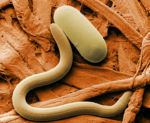Nematode Life Cycle
General Life-Cycle
In the complete nematode life cycle there are four larval stages, followed by the immature adult.
egg → L1 → L2 → L3 → L4 → adult
The direct life cycle is the most common. The free living larval stages undergoes two transformations after hatching. Infection occurs when the host ingests the free L3.
The intermediate life cycle involves an intermediate host. The first two moults usually occur in the intermediate host. Infection of the definitive host is either via ingestion of the intermediate host or by inoculation of the L3 by an intermediate host such as an insect.
Nematode Eggs
These vary greatly in appearance and are very useful for diagnosis as they can often be detected and counted in faecal samples NOTE: we use the typical strongyle egg to provide us with a yard-stick for comparing sizes. A "large egg", for example, means larger than a strongyle egg. A typical strongyle egg is approximately 80µm long.
